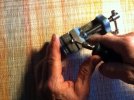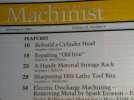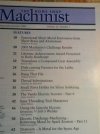If you use a reversible drill press, be sure to utilize a left handed drill bit. If your handle is Titanium, dissolve the screw with battery acid.I guess the size of the disc it depends on the size of the screw.
But as a rule I use a reversible drill press with a "backwards" bit so the cutting energy also tries to unwind the part. The press is important so that the bit won't skate off the head and mar other parts.
-
The BladeForums.com 2024 Traditional Knife is available! Price is $250 ea (shipped within CONUS).
Order here: https://www.bladeforums.com/help/2024-traditional/
You are using an out of date browser. It may not display this or other websites correctly.
You should upgrade or use an alternative browser.
You should upgrade or use an alternative browser.
Cutting slots in screws
- Thread starter Nocturnal13
- Start date
Wowbagger
Gold Member
- Joined
- Sep 20, 2015
- Messages
- 8,036
Here is a quick photo showing an example of a two handed grip.
The little vise is just something to hold the screw. If I were really cutting a slot in a screw that is in a component I would have the component solidly clamped in a vise or to a work table.
Note my left hand is braced on the component and is steadying the Dremel. It isn't clear but my index finger on my right hand is also on the component. This way I can make a pretty steady "milling" cut and refine the slot onced cut in.
Really. This isn't a big deal.
Don't load up on coffee before doing this if your hands shake nor do it when you are in a hurry.
All together now . . . slow breath in . . . and hold . . . and slow breath out
annnnnnnnnnd
reeeeeeeellllaaaaaaxxxxx.
PS: holding your breath while you cut helps too.

The little vise is just something to hold the screw. If I were really cutting a slot in a screw that is in a component I would have the component solidly clamped in a vise or to a work table.
Note my left hand is braced on the component and is steadying the Dremel. It isn't clear but my index finger on my right hand is also on the component. This way I can make a pretty steady "milling" cut and refine the slot onced cut in.
Really. This isn't a big deal.
Don't load up on coffee before doing this if your hands shake nor do it when you are in a hurry.
All together now . . . slow breath in . . . and hold . . . and slow breath out
annnnnnnnnnd
reeeeeeeellllaaaaaaxxxxx.
PS: holding your breath while you cut helps too.

Wowbagger
Gold Member
- Joined
- Sep 20, 2015
- Messages
- 8,036
Well . . . actually . . . many are. The torx and allen's I work with every day are most certainly hardened and will even kill a bimetal blade in, say, a normal hacksaw also a file skates on them.Screws are not normally hardened,
. . . so back to the cut off wheel for those.
The OP didn't specify what screw . . . just that it is stripped (I assume he means the socket in the screw head is rounded out).
- Joined
- Oct 31, 2009
- Messages
- 11,813
I wouldn't assume that the OP has your skills though. How many ways are there to "screw" it up?Over the last forty years I have cut conservatively 50 slots or more this way in small hardened allen key screws as well as torx to create screw driver slots to remove the screws. Never a problem.
One has to get a two handed grip on the Dremel. Practice a little if there is any question. One finds out pretty fast how to guide it.
One can stack two discs to get a wider slot in a larger screw head if needed.
Applying a lot of downward force on the screw driver helps.
For torx I have other methods but I have used the thin Dremel cut off wheels.
PS: people here keep telling me I can't cut nail nicks with the dremel (or the diamond wheels of the same ilk) . . .
and yet . . . oh look here's one
. . . as if by magic.
View attachment 961764
I like your description of your techniques though.

Wowbagger
Gold Member
- Joined
- Sep 20, 2015
- Messages
- 8,036
What's money when the life of a pocket knife is at stake !Electrical Discharge Machining. Kind of an expensive method of removing a screw for the average person. We have EDMs where I work and our shop would probably charge you anywhere from $50 to $100 to do it.
Or worse . . . the cosmetics of a pocket knife.
Wowbagger
Gold Member
- Joined
- Sep 20, 2015
- Messages
- 8,036
I wouldn't assume that the OP has your skills though. How many ways are there to "screw" it up?
I like your description of your techniques though.
I see . . . (thanks) . . .
in that case OP ; TO THE EDM !
- Joined
- Oct 31, 2009
- Messages
- 11,813
True that!What's money when the life of a pocket knife is at stake !
Or worse . . . the cosmetics of a pocket knife.
- Joined
- Oct 31, 2009
- Messages
- 11,813
Do you know what it takes to properly set up an EDM to burn out a screw in an oddly shaped object? It takes time and skill and it's probably out of most people's practical price range. Just sayin'!I see . . . (thanks) . . .
in that case OP ; TO THE EDM !
Wowbagger
Gold Member
- Joined
- Sep 20, 2015
- Messages
- 8,036
Here you go me hearties :You can build your own EDM. Look on youtube.
Apparently Home Shop Machinist magazine ran a whole series of articles (at least 11). All I found in my mess O' mags were these two. I assume #1 builds the machine. These are available on Amazon and second hand book stores. I love an old magazine hunt.


Wowbagger
Gold Member
- Joined
- Sep 20, 2015
- Messages
- 8,036
Do you know what it takes to properly set up an EDM to burn out a screw in an oddly shaped object? It takes time and skill and it's probably out of most people's practical price range. Just sayin'!
Fortunately for the world we're NOT most people.
WE ARE KNIFE DUDES ! ! !
with a library . . . and tools and stuff.
And with a bloody minded ATTITUDE.
Piece of pie !

PS: bloody minded as in . . .
I mentioned bloody-mindedness. This is a bit of British slang for a kind of stubbornness. Bloody mindedness means insisting on doing something well past when a reasonable person would quit. Monty Python sketches often made use of this trait. Vogon’s are bloody minded.
Last edited:
- Joined
- Dec 12, 2007
- Messages
- 2,601
I'm not sure what some of the people posting read. I side with Wowbagger just use the thin brittle cut off wheels .Touch them (while rotating)on an old sharpening stone to reduce the size then just tape around the screw recess and slot away. Unless this knife is of high value monetary or personal then try everything else first.
- Joined
- Jul 13, 2018
- Messages
- 9
I had the same problem last month, and used the brown cutting disc posted earlier in the thread (the one on the right). Worked out nicely, although a little stressful. You can see the results here:
https://www.bladeforums.com/threads/stripped-clip-screw-on-crux.1598635/#post-18262084
This was a tiny t6 screw, too. I did have to sacrifice the clip, but knew that going in.
https://www.bladeforums.com/threads/stripped-clip-screw-on-crux.1598635/#post-18262084
This was a tiny t6 screw, too. I did have to sacrifice the clip, but knew that going in.
Wowbagger
Gold Member
- Joined
- Sep 20, 2015
- Messages
- 8,036
I read the link.This was a tiny t6 screw, too. I did have to sacrifice the clip, but knew that going in.
I'm curious; did you whamp the screw first with a torx bit and hammer to weaken the thread locker first ? Did it seem to help? I did that for the first time at work a couple months ago on a hardened T25 that had rounded out (probably a badly formed screw from the factory). I did get it loose with a torx but it was still really locked in there EVEN AFTER HITTING IT. I'm not sure hitting it helped much. I used a brand new Torx bit that I touched the tip on a grinder to sharpen the end for more bite in the bottom of the torx.
The bit that rounded out was old but it had just loosened five other loctited screws exactly the same with no problem.
- Joined
- Jul 13, 2018
- Messages
- 9
I read the link.
I'm curious; did you whamp the screw first with a torx bit and hammer to weaken the thread locker first ? Did it seem to help? I did that for the first time at work a couple months ago on a hardened T25 that had rounded out (probably a badly formed screw from the factory). I did get it loose with a torx but it was still really locked in there EVEN AFTER HITTING IT. I'm not sure hitting it helped much. I used a brand new Torx bit that I touched the tip on a grinder to sharpen the end for more bite in the bottom of the torx.
The bit that rounded out was old but it had just loosened five other loctited screws exactly the same with no problem.
No, I didn’t, as I was a little nervous about damaging the threads in the titanium scale. I did, however, get it extremely hot using a hair dryer, and that helped a lot with the threadlocker. There was way more applied to that little clip screw than any others on the knife from the factory.
